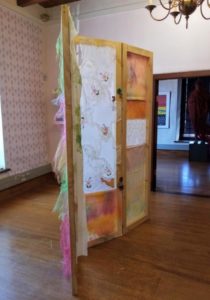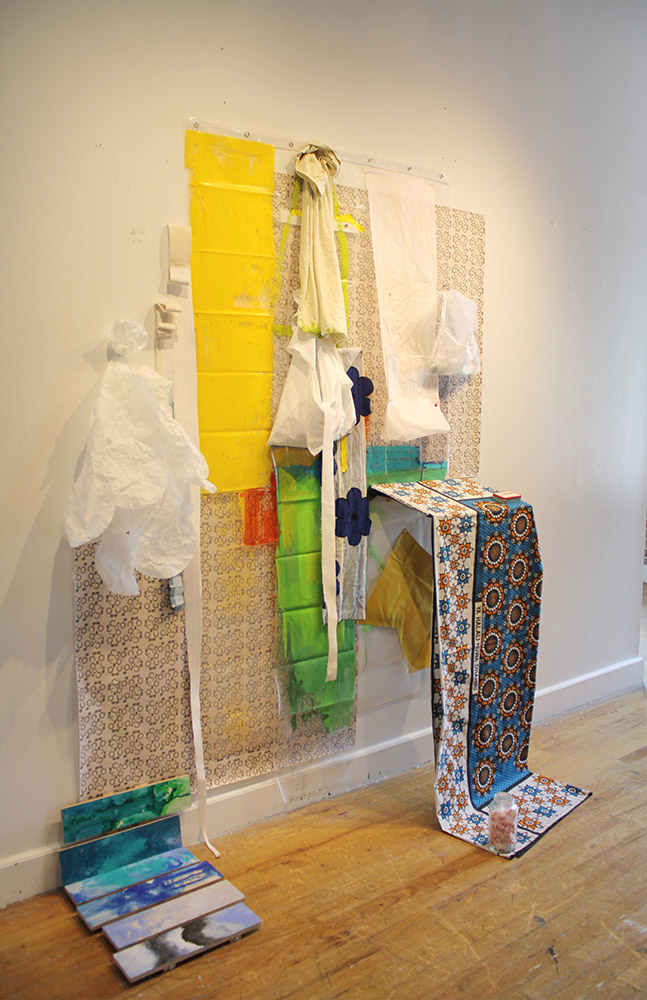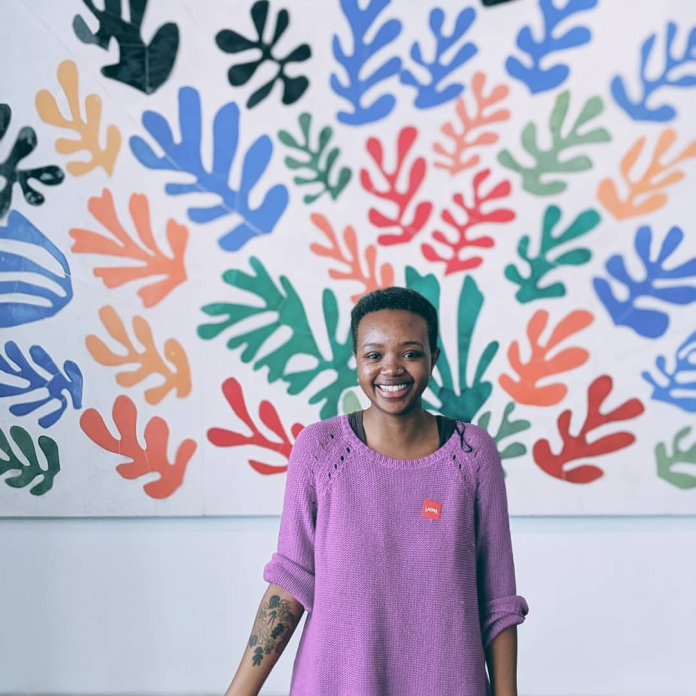by Don Handa
In February 2020, during the first-ever Stellenbosch Triennale, Agnes Waruguru’s work was exhibited in On the Cusp, a section dedicated to younger artists and collectives from Africa. In the words of Ghanaian curator, Bernard Akoi-Jackson, this section focuses on “revealing and unraveling the creative talents of tomorrow.”
On a hot afternoon, after hours spent on my feet taking in larger and louder too often unsubtle artworks – an exercise more wearying than I care to admit – Agnes Waruguru’s installation offered a welcome respite.
Homewares (2020) took the form of a room with light pink walls, featuring custom-designed wallpaper with a delicate, hand-drawn pattern. On one side was hung Valencia (2019) a vaguely topographic abstract drawing-painting on an old bed sheet incorporating paint, glass beads, and a strip of fabric cut from the edge of a khanga. On the opposite side of the room, through a large window, soft afternoon light spilled onto floating shelves on which were perched miscellaneous objects which included a can of Zesta orange marmalade, a kiondo lain on its side, glass beads in plastic mesh produce bags, an embroidery hoop, and a small framed photograph of her mother.

At the centre, between Valencia and the window, stood a room divider made up of three blonde wooden frames hinged together, their panes draped variously with old lace doilies, off-cuts from decades old upholstery fabrics, bed sheets and pillowcases, painted bits of canvas from the studio, and more plastic mesh bags. It is a masterful collage masquerading as a piece of furniture.
Based in Nairobi, Agnes Waruguru has a multifarious practice that encompasses drawing and printmaking to bookmaking, sculpture and installation. A painter by training – she studied at the Savannah College of Art and Design – she draws extensively from her home life and her creations are shot through with the traces of such acts as sewing, knitting, crocheting, and embroidery, many of these learned and inherited from the women in her life.
Stellenbosch marked her debut on the global art world’s mega-exhibition circuit. It was her first time creating a work on this scale, for an exhibition of this magnitude. In response to the challenge, she presented a work that brought together strands of thought that had been ongoing for a long time, making use of objects and materials that had been collected over years.
Speaking almost four months later, she has this to say to say about her Stellenbosch outing: “I did not expect to have that much space and I felt challenged do more, pushed to think about what I wanted to say, but also pushed to have boundaries and know that sometimes more is not more.”
On the whole, Homewares was restrained amidst a sea muchness, quietly eloquent where others were loud and brash. Waruguru leans on the power of suggestion. The joint appearance of a lace doily and a piece of upholstery fabric could bear you to your grandmother’s living room. Bible Story books stacked under a bedside lamp spark flashbacks to Sunday School — or memories, for those like me, of the antics involved in your avoidance of it. It spoke of home as a physical space, of the personal and shared memories that humdrum objects carry. These associations are the fodder for the work that she makes.
The marmalade jar in Homewares is an inside joke; in their family of six, no one but her dad eats marmalade, but it is never missing from the grocery list. Explaining that the work was years in the making, she says, “I think a lot of the way that I make happens that way. The work is constantly getting made even though I am not physically in the studio making it.”
Over the course of the interview, Agnes’s speech is soft and measured, interspersed with laughter bubbling up when she speaks of something funny, and the small recurrent joys of making as she does. She perks up, the pitch of her voice rising and her words speeding up ever-so-slightly when she lands on a particularly exciting aspect of her work, or some momentous occasion in the course of her career. The first time this happens in our conversation is when she talks about her ever-growing collection of plastic mesh grocery bags.
These moments, however, are most frequent when she goes on about creating with her hands, seeing the work come alive. She recollects one such moment; a love-at-first-sight encounter with printmaking during a school trip, “I was very into the process, very into the idea that you start out with an idea, you draw out your idea, you transfer it onto something else, and then you reproduce that image. The process, the cleaning, the way you mix the inks and the solvents – all that stuff felt like magic to me. It’s really cool.”
That class trip took place in the earlier years of a seven year stint during which Waruguru was away from home, returning for short periods at a time. The first was whilst studying for her IB diploma in Swaziland, then later in the USA where she studied first in California then later in Georgia. That time away, and the process of developing practices with which to ground oneself, to create a safe space in which to be as fully herself in a foreign place shaped much of what art making has been for Waruguru, and her interest in the idea of home that she continues to draw heavily on. “I think,” she muses, “being abroad really made me understand how much I value my home, and my culture, and my small rituals, family rituals.”
For as long as she can remember, she has struggled with the expectation that being a woman, she should default to the role of being a home-maker, that woman and home are two inseparable ideas. “I couldn’t grasp the thought that I am supposed to be a home-maker. I am very feminine, and as much as enjoy being a woman, and have a lot of respect for the work of home-making, it’s kind of like a battle, because I really don’t know how I fit into this idea.”
Her work, therefore, has become the site for figuring out these complexities. When she speaks of homemaking, she thinks of the slew of domestic work and tasks, material as well as emotional that go into upholding a home, work that she witnesses the women in her life doing, and the material evidence of that work.
“Growing up, because dad is like a workaholic, our home life was really about hanging out with my mom in the house. And I have two sisters, so my life is really about women, I’m surrounded by women. The more I think about my life, I cannot see myself being married to a man, having kids, cooking and cleaning, doing laundry… Doing laundry really is my worst activity. Fixing hems… It’s weird because I’ve started working with embroidery and I really enjoy doing the embroidery, but when my dad brings me trousers to fix his hem, I will procrastinate for days even though I know it will take me like ten minutes.”
She says all this in a matter-of-fact way, breaking into laughter as she talks. She describes the work as taking this power, this ability to make things with her hands, and using it to think about what home looks like for her. Home, in Waruguru’s words, is supposed to be a safe place, even though this is not always the case, and she is thinking about what that means, how to make a home for herself, and those dear to her. This pursuit is fuelled further by having experienced being away from home, and “living in a house that does not feel like a home.” What does home look like? What are the things that I am relating to?
For Waruguru, these are the questions at hand, and the answers are sought through observation and collection of objects that give clues to how she grew up. The experience of having people in Stellenbosch come up to her and tell her of the memories brought up by her work assured her that these questions resonate with many people from different backgrounds. Those near and dear to her, her mother, her sisters, her aunties have become her first audience.
She speaks of sharing her work with them with delight, noting that they have, over time, learned the logic of her work, and have become the first critics of her work. “Why did you do this?” “This one is different from the one before it.” She often invites them into the studio and asks their opinions of her work, and such statements have become commonplace.
Waruguru’s paintings, often done on cotton sheets instead of canvas, rarely make it onto stretcher bars. They are pinned to walls and drawn on, or lain on the floor then paint poured and dripped. Lines and patterns are as likely to be made with an ink pen as they are to be sewn. What from a distance might seem like an especially iridescent sliver of purple paint reveals itself, upon closer inspection, to be a string of glass beads. I witnessed a version of this some days after our interview when, at Nairobi’s Circle Art Gallery, director/curator Danda Jaroljmek is convinced that a series of marks on the lower left section of a drawing are embroidered on.
This time, it turns out, they are actually drawn.
For 2016’s Karibuni Chai (Welcome for Tea) she assembled coffee filters, tissue paper, pillowcases, khanga, intermingling these with inkjet prints, drawing, and canvas, painted wooden slats against a backdrop of shower-curtain repurposed as wallpaper. These accoutrements of personal living were tacked and pinned, folded, and draped, stuffed and layered, working in concert with traditional art making techniques such as painting and printmaking. Together, they resolved into abstract composition that pulses with colour and texture, that coming off the wall in a gesture anticipated the collage sensibility and sculptural impulse that continues to animate her work today.

When I ask her whether she considers herself a painter, she says, “I think I’m just someone who makes things, but I do approach a lot of my making as if it’s painting, but I think I’m just someone who makes things.” I ask her to elaborate, curious about a particular formulation she’s used during this conversation, the idea of building a painting. Her response to this: “I guess a painting can be anything as long as it is related to painting.” She pauses, then adds, mirthfully, “I’ve declared it.” Elaborating, she continues, “I think it’s because I was trained in painting that I think like that, and building a painting really just means: how many tools and what things that I’ve collected can I use to make a painting?”
During an artist talk for Lucid Dreams (2019), a group show I curated in Nairobi, she gave the example of how, instead of painting a bright green rectangle, she might choose to put in the bright green cover of the notebook she was holding in her hand as she spoke.
“It is also because, at the moment, a lot of my work is related to the wall, and so because of that it really feels like painting. But I am really trying to get out of that idea that it’s like painting on a thing . I am very interested in sculpture; as much as at the moment it’s still soft sculpture and very reliant on the wall, I’m trying to push myself to move away from that.”
The pull of Waruguru’s work does not consist simply in the mixing of objects, materials and techniques – something she does with a not inconsiderable measure of grace. It is in its intentionality, in the care and attentiveness to the lives of the elements she pulls into her work, their origins and their formal qualities. Each object exists in relation to the other, playing off and activating one another. The objects also show up in the work as photographs, as abstracted (drawn or painted) versions of themselves, and as references in the titles of works. One of the works in the Khanga Nzito series (2016-17) only uses small circular cutouts that register as small bull’s eyes along the lower edge of it’s pink expanse.
There is an abundance of mixed media work in Nairobi, an embarrassment of riches even. Large canvases heaving under the weight of everything from paint to dung, sculptures built from any number of found objects, polyester sheets and hessian in lieu of paper and canvas, steel woks transformed into confounded portraits – none of these is surprising. What one carries away from Waruguru’s work is the willingness to resist overt narrative and the legibility thereof as a necessary condition of her work – chiefly legibility to art collectors with easiest-available-metaphor sensibilities.
This is not to say that she has no appreciation for the need to communicate with her audience, nor of the unmoving reality that an artist working in Nairobi today has to make collectible work – it’s something she remains acutely aware of. How do you sell an abstract drawing on old sheer fabric hung from a dowel out through a hem on it’s top edge? It’s worth noting that Nairobi’s art market is still relatively small and partial to more traditional media, which usually translates to a rectangular object easily hung on a nail in the wall.
During summer breaks from college she would return to Nairobi and intern at Circle Art Gallery, as a means to stay connected to the local art scene and keep abreast the developments within. In September this year, she will be having her first solo show at Circle Art Gallery. She recalls that upon returning to Nairobi she was apprehensive about being able to exhibit her work in local galleries. On more than one occasion she was asked, “What are you doing? Do you make art?”
Fortunately, for Nairobi’s art scene, this did not deter her. That the work is not representational, that it is not easily “sellable” means that her work does not always easily conform to the criteria for many group shows. She talks about remaining open to having conversations and giving credit to her audience, trusting that they will be interested, and ask questions, and gain something from whatever they’re looking at.
Waruguru is grateful for the relationships that have grown over the past few years; friendships with other artists and communing with women in feminist and queer spaces. However, she expresses concern at what she feels are inadequate networks of support among artists. This is more pronounced for her as a woman, moving through a male-dominated scene whose “macho energy,” has often proven unwelcoming. Once, she had to move out of a studio space after just a few weeks for this very reason.
“I think there are a lot of good people in the art scene, I just don’t know what the one space where we come together and have healthy, wholesome conversations is.” In the absence of infrastructural support for the visual arts, she believes that community, and collaboration are key for setting up an art scene that benefits all participants, not just artists, but also members of the public.
As I wind up our conversation, I ask her about her upcoming solo show. How does she feel? Is she excited? She is. She is also confident and assured that it is the right time. She began making the works in the show in mid 2019, during a residency at Saba Studios in Lamu, along the northern coast of Kenya. Begun over a year ago, and having been through multiple thought cycles, Waruguru is confident that what she will present will be a complete thought.
“I want the show to uplift the importance of paying attention to the things around you, valuing your perspective. In a way, this is about ritual. It was really about taking walks every day, collecting things, and making based on a place. I hope it does justice to my time in Lamu, which was really about taking walks and paying attention to everything around me and letting chance lead the way. It is that, small things to consider. Having faith.”






